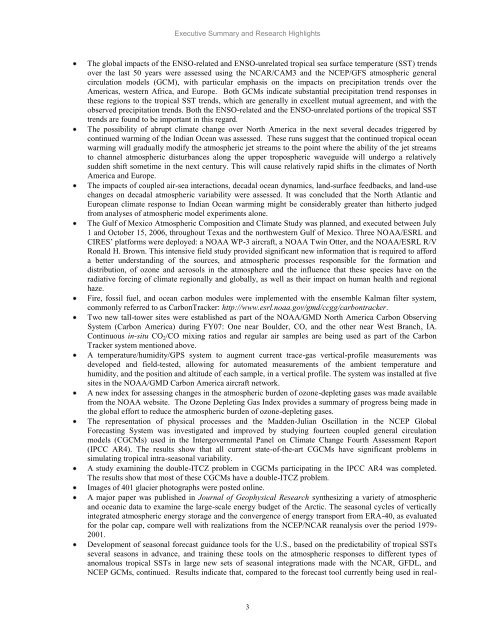Scientific Theme: Advanced Modeling and Observing Systems
Scientific Theme: Advanced Modeling and Observing Systems
Scientific Theme: Advanced Modeling and Observing Systems
You also want an ePaper? Increase the reach of your titles
YUMPU automatically turns print PDFs into web optimized ePapers that Google loves.
Executive Summary <strong>and</strong> Research Highlights<br />
The global impacts of the ENSO-related <strong>and</strong> ENSO-unrelated tropical sea surface temperature (SST) trends<br />
over the last 50 years were assessed using the NCAR/CAM3 <strong>and</strong> the NCEP/GFS atmospheric general<br />
circulation models (GCM), with particular emphasis on the impacts on precipitation trends over the<br />
Americas, western Africa, <strong>and</strong> Europe. Both GCMs indicate substantial precipitation trend responses in<br />
these regions to the tropical SST trends, which are generally in excellent mutual agreement, <strong>and</strong> with the<br />
observed precipitation trends. Both the ENSO-related <strong>and</strong> the ENSO-unrelated portions of the tropical SST<br />
trends are found to be important in this regard.<br />
The possibility of abrupt climate change over North America in the next several decades triggered by<br />
continued warming of the Indian Ocean was assessed. These runs suggest that the continued tropical ocean<br />
warming will gradually modify the atmospheric jet streams to the point where the ability of the jet streams<br />
to channel atmospheric disturbances along the upper tropospheric waveguide will undergo a relatively<br />
sudden shift sometime in the next century. This will cause relatively rapid shifts in the climates of North<br />
America <strong>and</strong> Europe.<br />
The impacts of coupled air-sea interactions, decadal ocean dynamics, l<strong>and</strong>-surface feedbacks, <strong>and</strong> l<strong>and</strong>-use<br />
changes on decadal atmospheric variability were assessed. It was concluded that the North Atlantic <strong>and</strong><br />
European climate response to Indian Ocean warming might be considerably greater than hitherto judged<br />
from analyses of atmospheric model experiments alone.<br />
The Gulf of Mexico Atmospheric Composition <strong>and</strong> Climate Study was planned, <strong>and</strong> executed between July<br />
1 <strong>and</strong> October 15, 2006, throughout Texas <strong>and</strong> the northwestern Gulf of Mexico. Three NOAA/ESRL <strong>and</strong><br />
CIRES‘ platforms were deployed: a NOAA WP-3 aircraft, a NOAA Twin Otter, <strong>and</strong> the NOAA/ESRL R/V<br />
Ronald H. Brown. This intensive field study provided significant new information that is required to afford<br />
a better underst<strong>and</strong>ing of the sources, <strong>and</strong> atmospheric processes responsible for the formation <strong>and</strong><br />
distribution, of ozone <strong>and</strong> aerosols in the atmosphere <strong>and</strong> the influence that these species have on the<br />
radiative forcing of climate regionally <strong>and</strong> globally, as well as their impact on human health <strong>and</strong> regional<br />
haze.<br />
Fire, fossil fuel, <strong>and</strong> ocean carbon modules were implemented with the ensemble Kalman filter system,<br />
commonly referred to as CarbonTracker: http://www.esrl.noaa.gov/gmd/ccgg/carbontracker.<br />
Two new tall-tower sites were established as part of the NOAA/GMD North America Carbon <strong>Observing</strong><br />
System (Carbon America) during FY07: One near Boulder, CO, <strong>and</strong> the other near West Branch, IA.<br />
Continuous in-situ CO2/CO mixing ratios <strong>and</strong> regular air samples are being used as part of the Carbon<br />
Tracker system mentioned above.<br />
A temperature/humidity/GPS system to augment current trace-gas vertical-profile measurements was<br />
developed <strong>and</strong> field-tested, allowing for automated measurements of the ambient temperature <strong>and</strong><br />
humidity, <strong>and</strong> the position <strong>and</strong> altitude of each sample, in a vertical profile. The system was installed at five<br />
sites in the NOAA/GMD Carbon America aircraft network.<br />
A new index for assessing changes in the atmospheric burden of ozone-depleting gases was made available<br />
from the NOAA website. The Ozone Depleting Gas Index provides a summary of progress being made in<br />
the global effort to reduce the atmospheric burden of ozone-depleting gases.<br />
The representation of physical processes <strong>and</strong> the Madden-Julian Oscillation in the NCEP Global<br />
Forecasting System was investigated <strong>and</strong> improved by studying fourteen coupled general circulation<br />
models (CGCMs) used in the Intergovernmental Panel on Climate Change Fourth Assessment Report<br />
(IPCC AR4). The results show that all current state-of-the-art CGCMs have significant problems in<br />
simulating tropical intra-seasonal variability.<br />
A study examining the double-ITCZ problem in CGCMs participating in the IPCC AR4 was completed.<br />
The results show that most of these CGCMs have a double-ITCZ problem.<br />
Images of 401 glacier photographs were posted online.<br />
A major paper was published in Journal of Geophysical Research synthesizing a variety of atmospheric<br />
<strong>and</strong> oceanic data to examine the large-scale energy budget of the Arctic. The seasonal cycles of vertically<br />
integrated atmospheric energy storage <strong>and</strong> the convergence of energy transport from ERA-40, as evaluated<br />
for the polar cap, compare well with realizations from the NCEP/NCAR reanalysis over the period 1979-<br />
2001.<br />
Development of seasonal forecast guidance tools for the U.S., based on the predictability of tropical SSTs<br />
several seasons in advance, <strong>and</strong> training these tools on the atmospheric responses to different types of<br />
anomalous tropical SSTs in large new sets of seasonal integrations made with the NCAR, GFDL, <strong>and</strong><br />
NCEP GCMs, continued. Results indicate that, compared to the forecast tool currently being used in real-<br />
3
















